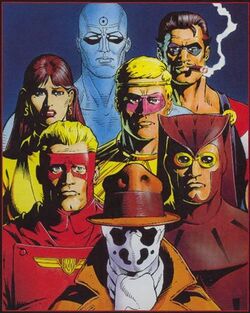HowTo:Write a novel

|
HowTo This article is part of Uncyclopedia's HowTo series. See more HowTos |
So, you want to write a novel. Salutations! The novel is a complex art, like a Rubik's cube, only one made up of words rather than fiddly coloured blocks, and mastering it requires discipline. As an example, my own novel Salivating the Locust[1] contains no less than twelve individual characters and two distinct sub-plots. (That's three whole plots, if you can't count!) The first known novel was The Bible, but when submitted to the publishers it was found to be one page too long for binding. The section entitled Other Works by the Same Author was therefore removed and the book was accidentally listed under "non-fiction," where it went on to become a best-seller. Since then the novel has become increasingly popular, and similar approaches have been used to boost sales for novels such as Newton's Principa Mathmatica, Charles Darwin's On the Origin of Species and The Da Vinci Code.
Like eldritch mist over water, novel writing can be a murky art, but this guide will take you by your trembling hand and open up the great vista of the creative art. The reasons for writing a novel are as numerous as hats in China, but for most people may perhaps be boiled down to the following:
- Sex
- Money
- Influence
- Sex
- Too lazy to do real work
- Sex
- Having nothing better to do due to a protracted illness
- Reading a Shaun Hutson book and thinking "any monkey could do this"
- Sex
- A vague sense that your uninspired vomitings are of any interest to anyone
If you fall into any of the above, welcome to the world of the writer! It has been proven in graphs that these are the best positions to begin your writing career from, with the listing for "genuine creative talent" not showing up at all, possibly because the talented tend to die young from drugs or guns. But fear not, following this handy guide will soon see the very skills of the world falling into your sweaty meat-palms!
The Theme[edit]
The most important thing for your novel to have is sheer dumb luck a solid concept. This can be created, half-created, or stolen outright from someone else. The latter option is easiest, whilst the first option is most likely to win you an award. The middle option, however, is the most popular, with most writers borrowing from a variety of sources, adding in an idea of their own (rarely more than one) and passing the resulting mess off as their own. J.K. Rowling, as an example, achieved fame by mixing Gandalf: The Early Years, the novel Noseless, and Victorian-era guides to childcare (for the scenes with Harry's uncle and aunt.)
There are lots of good themes out there, here's some suggestions:
- Racism
- Sexism
- Racist sexism
- War
- Racist war
- Drugs
- Racist soldiers taking drugs
- Getting rich quick
- Selling drugs to racist soliders to get rich
- Owls
Doing it Wrong[edit]
The theme must be both interesting and not too obviously stolen. Pankick Ramsy, in his failed novel War of the Huge Sharp Sword, spun a tale about a gnome having to return an evil, enchanted nose stud to the Crack of Fire. Sound familiar? Such liberal theft from a long-standing literary classic was abhorrent to the writing community, and Ramsy was given 100 lines to write by Thursday and a sharp warning not to do it again.[2]
Similarly, the novel Letters from the Back Line by Spiller Edison was an account of the Iraq war from the point of view of someone who was not a soldier, had nothing to do with the political process, and was generally ill-informed about the whole situation. The novel was therefore an account of the everyday doings of an insurance salesman, punctuated with the occasional drunken argument about the actions of the government. Despite memorable lines such as "they're all fucking terrorists I tell you!" and the protaganist's own declaration that "Bush is a stupid wanker!" the novel failed to draw the attention of anyone as it was completely pointless and boring.
Doing it Right[edit]
In my own novel, The Alphabet of the City,[3] I mixed the disassociative elements found in American Psycho and the sexual politics of Belle de Jour with the varied wisdom of the London A-Z guide, creating an Urban Noir tale in which a London taxi driver is driven to a violent killing spree over his desire to save a prostitute. You can see immediately the difference between this and our previous examples. Here an original idea has been formed from several well-established sources, all of which have stood up to critical scrutiny and can be seen as suitable platforms to launch one's own work from.
The Opening[edit]
The opening of a novel is the most important bit, far more important than the middle or end. This is for the simple reason that, should they find your novel in a shop, most readers will read the first sentence to decide if they want to buy it (those that don't are freaks, or sometimes critics, and you don't want them among your fanbase). If the opening sentence is good then KA-CHING for you!
A good opening should give an overview of the whole novel. It is perhaps best to think of the opening as a commercial for your work, giving audiences a chance to view your wares before purchase. If your piece is a comedy, make sure the opening is funny. If it is a tragedy, then try and kill at least two characters before the end of the first paragraph. If it is a mixture of the two then you may wish to consider murdering a clown as a compromise.
Don't ever open with a scene from the middle, or the end, of your novel. This is a form of time travel, which is currently illegal.
Doing it Wrong[edit]
The dreadful, insignificant toss that was James Joyce's Finnegan's Brake is a prime example of a poor opening for a novel. The "text" opens as follows:
“riverrun, past Eve and Adam's, from swerve of shore to bend of bay, brings us by a commodius vicus of recirculation back to Howth Castle and Environs.”
As you can see, such gibberish is anathema to those of us who take our art seriously. It is drivel such as the above which ensured James Joyce is now a complete nobody, his current whereabouts unknown but believed to be a whiskey bar in Peru. As an overview it fails in every sense, as it is in fact a continuation of the novel's closing sentence, which runs:
“Wow, I cannot believe you actually read this far. I guess I lose that bet with Beckett, then. Allright, you want a real challenge? Try doing it all again. A-one, a-two, a-one, two, three, four”
Clearly Mr. Joyce had little to no interest in the most important elements of literature. If he did, then he would never have dropped such a clunker. Poorly played, Jimmy Joyce, poorly played indeed.
Doing it Right[edit]
I open my novel Quinine and Linen[4] with this sublime (if I do say so myself) piece of wordsmithery:
“The dome was curved, like the head of a mushroom, as Inspector <insert name here> smiled quickly to himself. It was no job, no, no job at all at his age, not to be doing this so early in the morning. The dead body stared at him.”
Immediately we have a sense of place (the dome), a sense of character (the inspector is getting old) and a sense of mystery (somebody[5] is dead). A prospective reader will pick this up and be able to glean what the novel is about. They will then, of course, want to know what happens next, and that's when you will start your rise to success! Just remember who set you on this path, won't you?
Characters[edit]
These are the people who you include in your novel. They can have any name, though it's advisable to pick a recognised name for your first effort. Examples of this include Dave, Jane, Patrick Bateman, Dumbo or the Mark Twain favourite, Nigger Jim. Characters are vital to a novel, as you can probably determine by simply looking around at the world and asking yourself "would anything happen without people?" The answer is of course that yes, it would, but the events would all centre around animals, which nobody wants to read about except children and senile grandparents.
Doing it Wrong[edit]
Nobody wants to read about complicated characters. If you've ever had a friend with "issues," you'll know how depressing and whiny they can be. Is this something you want people to associate with your novel? Of course not, so be sure to keep your characters nice and simple. One or two character traits should be sufficient. Some authors feel that "character development" is a key factor in writing, and that "multi-faceted" personalities are something a reader will engage with. This is patent patooey. Most readers have barely any personality themselves, which is why they read books rather than taking part in reality TV, so reading about someone as well-rounded as, say, Jade Goody will certainly prove beyond them. Writers in the fantasy field (Tolkien and David Eddings, in particular) are often the finest exponents of this style of character-creation, and it is advisable to read as much of their work as possible.
Doing it Right[edit]
The characters I like to create are streamlined, effective and have some notable feature (or "quirk") that helps them stand out from the background cast. In my novel Flapping Without Featherbeds[6] I created the character of Clayton Purvis, one of my finest creations to date (not to sound immodest!) I created him using a simple three-part method, which I will explain here, using Clayton as an example.
Part One: The Primary Characteristic[edit]
The primary characteristic is simply that; the main mood or state of of being for a character. Clayton is a surly person. This is how he acts nearly all of the time, which makes him readily identifiable with readers because they probably know some moody people as well. Characters such as Clayton frequently show up in other forms of media.
Giving many of your characters names that start with the same letter makes them easy to remember. Tolkien used this technique when writing The Silmarillion. Never has there been a book so easy to understand.
Part Two: The Secondary Characteristic[edit]
The secondary characteristic is the way the character behaves some of the time, but not often. It is important that this characteristic appears rarely, otherwise your reader may get it confused with the primary characteristic and lose the direction of the plot. This may result in them no longer buying your books. In the example of Clayton, his secondary characteristic is that he can sometimes be very kind. Not very often, but just often enough that the reader can see that beneath his surly exterior he is a good person. This kind of dual-characerising is extremely rare in novels, though some TV shows are beginning to utilise it, and it is one I intend to pioneer further.
Part Three: The Quirk[edit]
Clayton is a ginger. Gingers are funny, see?
The Ending[edit]
Whilst not as important as the beginning, as readers will have purchased the book by this point and do not need further impressing, a passable ending is still worth including. Remember, your novels are not a finite resource. By changing small elements of the plot each time, or even just the character names, there is nothing to stop you writing tens or even hundreds of novels a year! (Just look at Stephen King for an example of a true pioneer of this approach.) This is no good, however, if you put your readers off purchasing your next opus by leaving them deeply unsatisfied at the climax (see Tabitha King), so your novel must end with something slightly better than "it was all a dream, the end," no matter how easy or tempting this may seem. The three most important words when writing an ending are Plot Twist, Plot Twist, Plot Twist. Indeed, these three words are so important it takes six words to contain them.
Doing it Wrong[edit]
Some novels contain plot twists throughout, or create a plot sufficiently complex that the reader is never sure what's going to happen, making a plot twist impossible. Noted author George R.R. Martin does this in the series A Song of Ice and Fire, for example. It is a technique to avoid at all costs. All artistic reasons aside, just think of the workload. Creating a three-dimensional world with a convincing history and characters with "realistic" emotions could delay your novel by up to a month![7] Remember, a minute more spent on your work is a minute you could be spending surrounded by models on your private boat, so you'd best get moving if you want to enjoy your well-earned Mojitos.
Doing it Right[edit]
At the epic conclusion of my three-part series Getting Rich in Chipping Sodbury[8] I introduced a plot twist that will one day be counted as "legendary". With this novel I tried, and succeeded, to challenge the casual sexism of a society who will automatically assume a given person is male, unless explicitly told otherwise. Up until this point in the story, the reader has been labouring under the impression that central character Butch "Shagalot" McHardasfuck is a man. The final scene takes part in a brothel Butch has been frequenting, a face-off between the character and his ex-wife. Except, of course, we suddenly discover that it isn't his ex-wife at all. Butch is a woman. The assumptions readers have made about her gender are nothing more than ill-conceived stereotyping, from a public who still dismiss women as inferior. The reader leaves surprised and, hopefully, just a little bit wiser.
In Conclusion[edit]
You now have all the knowledge you need to write a highly successful novel. No, no need to thank me, it's what I do. If you truly want to say thank you, then simply don't forget me when you're at the top. I have a new novel ready, entitled What I Want to do to that Bastard who Rejected my Novel 'Fights and Clocks,'[9] the Bastard.[10] So if you happen to have a meeting with your publisher, and you have some time to spare, why not have a word with him about it.
Notes[edit]
- ↑ Currently unpublished.
- ↑ He did it again.
- ↑ Currently unpublished.
- ↑ Currently unpublished.
- ↑ Not a clown, as there is no comedy in this novel.
- ↑ Currently unpublished.
- ↑ It's delaying George R.R. Martin's by over five years.
- ↑ Currently unpublished.
- ↑ Currently unpublished,
- ↑ Currently unpublished.
See Also[edit]
| Featured on the 12th of February 2011 | |
This HowTo has been featured on the HowTo: namespace. Want to know HowTo get your own HowTo featured? Just write something good.
| |


